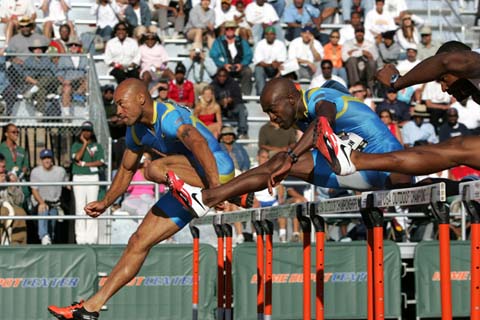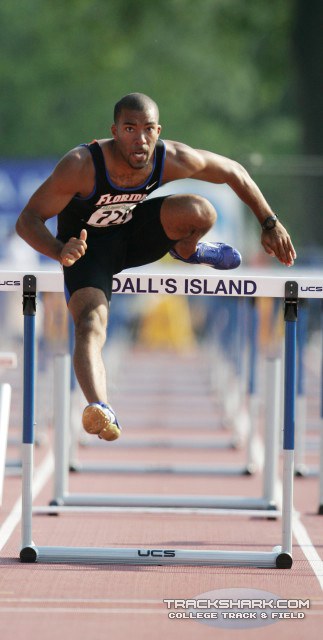Even some of the very best hurdlers in the world, while negotiating a barrier, will have a moment of pause during hurdle clearance, when the lead leg is on top of the hurdle. This article will discuss the causes of that pause, however obvious or subtle it may be, and discuss ways to eliminate it so that the hurdling motion is a seamless, flowing one.
The pause on top of the hurdle is worst for hurdlers who lock their lead leg knee. These hurdlers will “pose” on top of the hurdle, meaning that all motion stops for an instant, and it looks as though they are posing for a snapshot before bringing their lead leg back down to the ground. When talking about the most technically proficient hurdlers out there (Allen Johnson, Dominique Arnold, etc.), we often use words like fluid, smooth, and graceful to describe their hurdling style. These are the hurdlers that we try to emulate, because these are the hurdlers who make hurdling seem effortless.
One of the reasons that a lot of hurdles lack fluidity in their hurdling style is because their muscles aren’t conditioned to perform the required movements. It is not possible to over-emphasize the importance of flexibility when it comes to being able to hurdle gracefully, with ease of motion. If the muscles are not elastic enough, then the motion of getting over the hurdle will be too much of an effort, and the strain caused by trying so hard will make the hurdling motion a herky-jerky one in which the phases of hurdle clearance are noticeably distinguishable.

Dominique Arnold (left) and Allen Johnson (middle) exhibit the fluidity of motion that makes them elite hurdlers.
To put it simply, the reason that there is a pause in the hurdle motion is because something has stopped moving. Either the trail leg or the lead leg is not moving, but is instead hanging, waiting, drifting. Ideally, the lead leg never stops moving from the time it leaves the ground to the time it touches back down on the ground. Ideally, the trail leg never stops moving from the time it leaves the ground to the time it touches back down on the ground. There is a synchronicity of motion that you’re trying to achieve, and you will know that you have achieved it when hurdling feels effortless.
Although aggression is one of the main qualities that a hurdler needs to have, the aggression needs to be a controlled aggression; otherwise, it is counter-productive. Males, in particular, will tend to hurdle too aggressively at times. Of course, you want to hurdle aggressively; hurdling effectively is all about staying in attack mode, driving the knee at the crossbar, etc. But hey, leave some hurdles up for the next guy, will ya? Hurdlers who bull-doze hurdles or bum-rush hurdles with reckless abandon tend to leave their trail leg in their back pocket and just bring disorganized lead-leg ruckus to and through the barriers. Such hurdlers are too reliant on their speed and power, and thus are always, in a sense, “fighting” the hurdle. In such cases, because the trail leg is in pause mode during hurdle clearance, the lead leg stays parallel to the track longer than desired, and the hurdler’s hip and shoulder alignment gets all messed up. The lead leg wants to snap down, but it cannot do so because the paused trail leg is throwing the whole body off-line.
On the flipside of that problem, hurdlers who are afraid of hitting hurdles, afraid of getting scarred up and bruised, will clear hurdles too high; they will, in effect, “jump” over the hurdle. When you jump, whether you’re long-jumping, high-jumping, jumping to dunk a basketball, jumping to catch a frisbee, jumping over a puddle, or jumping over a hurdle, you’re going to pause at full height before you begin to come back down. That’s the closest thing to a science lesson you’ll get on this website. Anyway, in such a case, a hurdler who jumps over hurdles is going to have a bored trail leg with nothing to do. It wants to start driving upward, it wants to get to the other side of the obstacle, but it can’t do anything except hang there until the lead leg finally begins its downward flight.
Often, because we conceptualize the hurdle motion as consisting of phases, and because, in practice, we generally tend to concentrate on improving only one phase at a time, we subsequently tend to actually hurdle in phases as well. Take-off, lead with the knee, drive at the crossbar, snap the lead leg down, drive the trail leg through. Different schools of thought use different terminology in an attempt to re-train the brains, and consequently the bodies of their hurdlers, so that the hurdlers don’t think in terms of phases, but in terms developing one continuous motion. Jean Poquette, whose coaching philosophy I have discussed at length in other articles on this website, would use the word “unitize;” he wouldn’t tell his hurdlers to “pull the trail leg through,” but to unitize it with the lead leg. Allen Johnson’s coach, Curtis Frye – and I hope he doesn’t mind me mentioning this, but I learned it at his clinic last year – would use the term “rotary hurdling,” which is another way of saying, more or less, the same thing Poquette was saying, which is that both the lead leg and the trail leg are constantly in motion throughout hurdle clearance. So, instead of thinking lead leg then trail leg, think lead leg and trail leg. Unitize, keep it flowing, keep it fluid.

2004, 2005 110mHH NCAA champ Josh Walker of Florida.
In my formative years as a hurdler, I was always taught that the force of snapping down the lead leg propels the trail leg upward, underneath the armpit, so that, in terms of consciously working on the trail leg motion, all you would have to do, once you had developed your lead leg to the point where it was quick, snappy, and efficient, was work on closing the gap in the groin of the trail leg, so that the knee of the trail leg was facing the next hurdle by the time the lead leg foot touched down. A lot of coaches today flip the script on that line of reasoning, choosing instead to emphasize that the thrust of the trail leg upward, when the lead leg is on top of the hurdle and the chest is pushing down on the lead leg, will cause the lead leg to drop straight downward of its own accord, without you needing to consciously push it down.
Being old-school, I’m a lead-leg-first kind of guy, and I still emphasize the lead leg first when coaching my hurdlers, especially when working with beginning hurdlers. But the other way works too. The trail leg driving upward underneath the armpit does, indeed, cause the lead leg to cut straight down to the ground. With both modes of thinking, though, there is a momentary pause on top of the hurdle. It may be a slight, infinitesimal pause that only the very well-trained eye can perceive, but there is a pause on top. True unitization, to use Coach Poquette’s term, involves doing both – snapping down the lead leg as a means of driving up the trail leg, and driving up the trail leg up as a means of snapping down the trail leg, at the same time. Mentally, this is a very difficult thing to do, and it takes an open mind and true spirit of adventure to actively pursue this line of thinking. But it works. When the lead leg and trail leg are working together in perfect harmony, when they are both in a state of continuous movement, there is no greater feeling in the world.
When you finally have that synchronicity of motion, you are finally hurdling. The motion is so fluid that it doesn’t really even feel like you’re hurdling at all, but just sprinting. And to the observer, it doesn’t really look like you’re hurdling, which creates what Renaldo Nehemiah calls “the wow factor.” God only knows how many hundreds of reps, how many thousands of reps, how many dark moments of frustration and despair, until that feeling finally comes. And it is a feeling. You don’t really know you know how to hurdle until your body informs you that you do, not your coach, not your time on the watch, not your first-place finish. But once that feeling does come – and it may occur during a practice session, so always be ready – it will change your whole outlook on hurdling. It feels weird to hurdle with absolutely no pause whatsoever on top. Seek that feeling. And once you find it, seek to repeat it, over and over again.
© 2005 Steve McGill
